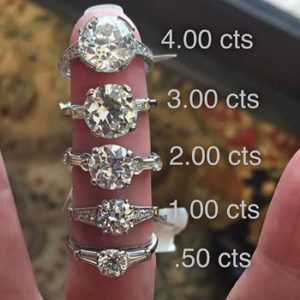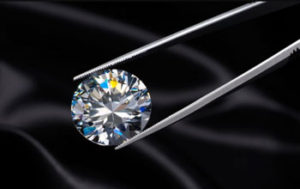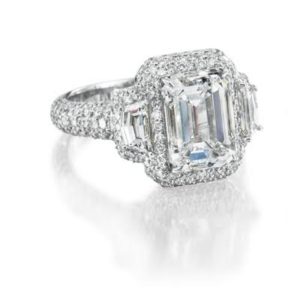How are diamonds priced?
Many people are confused about how diamonds are priced. The best explanation is that asking for the price of a diamond is like asking for the price of a house. A real estate agent can’t quote you a price for a house without knowing its size, condition, location, etc. This process is the same one used when buying a diamond. A diamond’s beauty, rarity, and price depend on the interplay of all the 4Cs : cut, clarity, carat, and color.
The 4Cs are used throughout the world to classify the rarity of diamonds. Diamonds with the combination of the highest 4C ratings are more rare and, consequently, more expensive. No one C is more important than another in terms of beauty and it is important to note that each of the 4Cs will not diminish in value over time.
Once you have established those 4C characteristics that are most important to you, a Pruett’s Jewelry gemologist can then begin to show you various options with quoted prices.
The Diamond Quality Pyramid
The Diamond Quality Pyramid is a framework to help you compare diamonds. While all diamonds are precious, those closest to the top of the pyramid possessing the best combination of cut, clarity, carat weight and color are the earth’s rarest and most valuable
Carat
 Carat refers to the weight of a diamond.
Carat refers to the weight of a diamond.
Carat is often confused with size even though it is actually a measure of weight. One carat is equivalent to 200 milligrams. One carat can also be divided into 100 points. A .75 carat diamond is the same as a 75-points or 3/4 carat diamond.
A 1-carat diamond costs exactly twice the price of a half-carat diamond, right? Wrong. Since larger diamonds are found less frequently in nature, which places them at the rarest level of the Diamond Quality Pyramid, a 1-carat diamond will cost more than twice a 1/2-carat diamond (assuming color, clarity and cut remain constant).
Cut and mounting can make a diamond appear larger (or smaller) than its actual weight. So shop around and talk to your jeweler to find the right diamond and setting to optimize the beauty of your stone.
Clarity
 Clarity refers to the presence of inclusions in a diamond.
Clarity refers to the presence of inclusions in a diamond.
Every diamond is unique. Nature ensures that each diamond is as individual as the person who wears it. Naturally-occurring features known as inclusions provide a special fingerprint within the stone. Inclusions are natural identifying characteristics such as minerals or fractures, appearing while diamonds are formed in the earth. They may look like tiny crystals, clouds or feathers.
To view inclusions, jewelers use a magnifying loupe. This tool allows jewelers to see a diamond at 10x its actual size so that inclusions are easier to see. The position of inclusions can affect the value of a diamond. There are very few flawless diamonds found in nature, thus these diamonds are much more valuable.
Inclusions are ranked on a scale of perfection, known as clarity, which was established by the Gemological Institute of America (GIA). The clarity scale, ranging from F (Flawless) to Included (I), is based on the visibility of inclusions at a magnification of 10x.
Some inclusions can be hidden by a mounting, thus having little effect on the beauty of a diamond. An inclusion in the middle or top of a diamond could impact the dispersion of light, sometimes making the diamond less brilliant.
The greater a diamond’s clarity, the more brilliant, valuable and rare it is, and the higher it is on the Diamond Quality Pyramid.
Color
Color refers to the degree to which a diamond is colorless.
Diamonds are found in almost every color of the rainbow, but white-colored diamonds remain most popular.
Diamonds are graded on a color scale established by the Gemological Institute of America (GIA) which ranges from D (colorless) to Z. Warmer colored diamonds (K-Z) are particularly desirable when set in yellow gold. Icy winter whites (D-J) look stunning set in white gold or platinum.
Color differences are very subtle and it is very difficult to see the difference between, say, an E and an F. Therefore, colors are graded under controlled lighting conditions and are compared to a master set for accuracy.
Truly colorless stones, graded D, treasured for their rarity, are highest on the Diamond Quality Pyramid. Color, however, ultimately comes down to personal taste. Ask a jeweler to show you a variety of color grades next to one another to help you determine your color preference.
Nature has also created diamonds in intense shades of blue, green, yellow, orange, pink or, rarest of all, red. These diamonds are called “colored fancies” and are extremely rare and highly treasured.
Cut
 Cut refers to the angles and proportions of a diamond.
Cut refers to the angles and proportions of a diamond.
Nature determines so much about a diamond, but it takes a master cutter to reveal the stone’s true brilliance, fire and ultimate beauty.
Based on scientific formulas, a well-cut diamond will internally reflect light from one mirror-like facet to another and disperse and reflect it through the top of the stone. This results in a display of brilliance and fire, thereby placing well-cut diamonds higher on the Diamond Quality Pyramid than deep or shallow-cut diamonds. Diamonds that are cut too deep or too shallow lose or leak light through the side or bottom, resulting in less brilliance and ultimately, value.
Cut also refers to shape: round, square, pear, or heart for example. Since a round diamond is symmetrical and capable of reflecting nearly all the light that enters, it is the most brilliant of all diamond shapes and follows specific proportional guidelines. Ask a jeweler to find out more about these guidelines.
Non-round shapes, also known as “fancy shapes”, will have their own guidelines to be considered well-cut.
What to Spend
Buying a diamond means investing in a piece of forever. A true miracle of nature dating from the beginning of time, each diamond purchase is special.
Every individual buying a diamond seeks out the best they can afford. Nature’s variety means that you will always find a diamond to suit your taste, budget and occasion. We have all heard the 2 months salary guideline put on by the media and thats fine if it is within your budget. If you’re about to buy a diamond engagement ring, I always recommend spending what YOU feel comfortable with. Simple as that. There are no set monetary requirements that you should confine yourself to when making your purchase. Pruett’s jewelry has a fine diamond to fit every budget.
You can rest assured that the diamond you buy will be a sound financial investment. Their rare qualities have been sought after for thousands of years. Their desirability and value remain undiminished today and will continue through the years to come.
But, whatever you spend, your diamond will represent one of life’s deepest emotional investments. It may eventually be passed down for generations, cherished not just for what it is worth, but for what it means.
Buy With Confidence – the 5th C
Pruett’s Jewelry is the first step to a smart diamond purchase. We are the longest standing independently owned jewelry store in Odessa for a reason. Not only will we have your best deal on certified high quality diamonds, but we will also educate you about your diamond so that you will feel confident with your very important investment.

